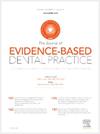预防干预对正畸引起的白斑病变的影响:一个概括性的回顾和证据映射
IF 4
4区 医学
Q1 DENTISTRY, ORAL SURGERY & MEDICINE
引用次数: 0
摘要
目的总结和评价有关正畸诱导白斑病变预防干预措施的系统综述(SRs),并绘制该领域现有证据图谱。材料与方法截止到2024年6月20日,我们在PubMed、Embase、Web of Science、Cochrane Reviews、Scopus、万方、CNKI等7个数据库中进行了电子检索,没有任何限制。筛选、数据提取和质量评估(使用AMSTAR 2和ROBIS)由2位作者独立完成,一式两份。对结果进行总结和定性分析。应用证据映射来显示当前的证据和研究差距。结果共纳入24例SRs。根据ROBIS,只有少数SRs具有“低”偏倚风险(n = 4),或根据AMSTAR 2具有“高”(n = 1)或“中等”总体置信度(n = 2)。证据图谱描述了干预措施的多样性,并在纳入的SRs中确定了27种不同的比较。再矿化剂是最常评估的干预措施类型,而在少数SRs中研究了自行应用的抗菌剂和机械清洁程序。与对照组/安慰剂相比,局部氟化物应用、与口腔卫生相关的提醒剂和密封剂在预防wsl方面有效。没有足够的证据支持其他干预措施的有效性。结论关于wsl预防干预的高质量SRs数量有限。针对wsl存在多种预防干预措施,但目前大多数SRs侧重于再矿化剂。需要更多高质量的随机对照试验来增加证据的确定性并指导临床实践。RegistrationPROSPERO (CRD42023428516)。本文章由计算机程序翻译,如有差异,请以英文原文为准。
THE EFFECTS OF PREVENTIVE INTERVENTIONS FOR ORTHODONTICALLY INDUCED WHITE SPOT LESIONS: AN UMBRELLA REVIEW AND EVIDENCE MAPPING
Objectives
To summarize and evaluate systematic reviews (SRs) regarding preventive interventions for orthodontically induced white spot lesions (WSLs) and map currently available evidence in this field.
Materials and methods
An electronic search was conducted up to 20 June 2024 in the following 7 databases with no restrictions: PubMed, Embase, Web of Science, Cochrane Reviews, Scopus, WanFang, and CNKI. Screening, data extraction, and quality assessment (using AMSTAR 2 and ROBIS) were performed by 2 authors independently and in duplicate. Results were summarized and analyzed qualitatively. Evidence mapping was applied to display current evidence and research gaps.
Results
A total of 24 SRs were included. Only a few SRs were of ‘low’ risk of bias (n = 4) according to ROBIS, or of ‘high’ (n = 1) or ‘moderate’ overall confidence (n = 2) according to AMSTAR 2. The evidence mapping depicted the diversity of interventions, and 27 different comparisons in included SRs were identified. Remineralizing agents were the most frequently assessed types of interventions, while self-applied antibacterial agents and mechanical cleaning procedures were studied in few SRs. Topical fluoride applications, oral hygiene-related reminders and sealants were effective in preventing WSLs compared to control/placebo. No sufficient evidence supported the effectiveness of other interventions.
Conclusion
The number of high-quality SRs regarding the preventive intervention of WSLs is limited. Various preventive interventions for WSLs exist, but most current SRs focus on remineralizing agents. More high-quality randomized controlled trials are required to increase the certainty of evidence and to guide clinical practice.
Registration
PROSPERO (CRD42023428516).
求助全文
通过发布文献求助,成功后即可免费获取论文全文。
去求助
来源期刊

Journal of Evidence-Based Dental Practice
DENTISTRY, ORAL SURGERY & MEDICINE-
CiteScore
6.00
自引率
16.70%
发文量
105
审稿时长
28 days
期刊介绍:
The Journal of Evidence-Based Dental Practice presents timely original articles, as well as reviews of articles on the results and outcomes of clinical procedures and treatment. The Journal advocates the use or rejection of a procedure based on solid, clinical evidence found in literature. The Journal''s dynamic operating principles are explicitness in process and objectives, publication of the highest-quality reviews and original articles, and an emphasis on objectivity.
 求助内容:
求助内容: 应助结果提醒方式:
应助结果提醒方式:


